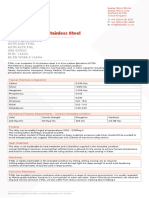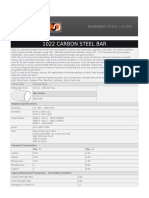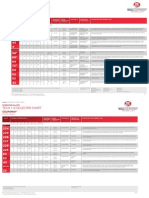F316 Austenitic Stainless Steel: Related Specifications
F316 Austenitic Stainless Steel: Related Specifications
Uploaded by
aleeimeranCopyright:
Available Formats
F316 Austenitic Stainless Steel: Related Specifications
F316 Austenitic Stainless Steel: Related Specifications
Uploaded by
aleeimeranOriginal Title
Copyright
Available Formats
Share this document
Did you find this document useful?
Is this content inappropriate?
Copyright:
Available Formats
F316 Austenitic Stainless Steel: Related Specifications
F316 Austenitic Stainless Steel: Related Specifications
Uploaded by
aleeimeranCopyright:
Available Formats
Beeley Wood Works
Beeley Wood Lane
Sheffield S6 1ND
United Kingdom
T: +44 (0)114 231 2271
F: +44 (0)114 232 4983
E: info@abbeyfp.co.uk
F316 Austenitic Stainless Steel
Related Specifications
ASTM A182 F316
ASTM A276 316
UNS S31600
W.Nr. 1.4401
BS EN 10088-3 1.4401
F316 is an Austenitic Cr-Ni stainless steel second only to F304 in commercial importance. F316 contains an addition
of Molybdenum that gives improved corrosion resistance, particularly pitting and crevice corrosion in Chloride
environments.
The Material is always supplied in the Solution Annealed condition.
Initially developed for use in paper mills, F316 is now typically used in many industries including Food processing,
Brewing, Marine, Automotive, Aerospace, Mining, Medical, Oil and Gas, in fact in all applications where enhanced
corrosion resistance is required.
Typical Chemical composition
Carbon 0.08% Max
Silicon 1.00% Max
Manganese 2.00% Max
Phosphorous 0.045
Sulphur 0.030
Chromium 16.0 - 18.0
Nickel 10.0 - 14.0
Molybdenum 2.00-3.00
Mechanical Property Requirements – Solution Annealed condition
Yield Tensile Strength Elongation Hardness
205 Mpa Min 515 Mpa Min 30% Min 215 HB Max
Forging
This alloy can be readily forged at temperatures 1000 – 1200Deg.C
Hot working below 927Deg.C should be avoided.
The low carbon content of these alloys ensures no heavy scale but excessive soak times should still be avoided to
avoid enlarged grain size, suggest 15minutes per inch (25mm) of maximum ruling section
Heat Treatment
This alloy is not hardenable by heat treatment and is therefore supplied in the Annealed condition.
Anneal 1040Deg.C minimum, ensuring that sufficient time is allowed for the centre to achieve furnace temperature
and hold for a time commensurate with the ruling section, followed by rapid cooling in Water.
Machining
F316 is readily machinable in the annealed condition by milling, drilling, turning, etc as required.
Cutting edges should be kept sharp and cuts should be kept light but deep enough to avoid work hardening.
Coolants and lubricants should be used in large quantity.
Corrosion Resistance
F316 has excellent corrosion resistance when exposed to a range of corrosive environments. It is usually regarded as
Marine grade stainless, however it is not resistant to warm sea water. Warm Chloride environments can cause pitting
and crevice corrosion. F316 will also suffer from stress corrosion cracking above 60Deg.C
Registered in England and Wales. Company Registration No: 1644542
Oxidation Resistance
This alloy has good resistance to oxidation in intermittent service upto 870Deg.C and in continuous service
upto 925Deg.C. However continuous use between 425 – 860Deg.C is not recommended if corrosion resistance
in water is required. In this instance the lower carbon variant F316L is recommended due to its resistance to
carbide precipitation.
When high strength at temperatures above 500Deg.C is required, grade F316H is recommended.
Welding
Austenitic stainless steels are generally considered to be weldable by the common fusion and resistance techniques
but special consideration is required to avoid hot cracking of the weld metal.
Registered in England and Wales. Company Registration No: 1644542
You might also like
- Hastelloy C276 / Alloy C276 / UNS N10276 / DIN 2.4819Document3 pagesHastelloy C276 / Alloy C276 / UNS N10276 / DIN 2.4819SamkitNo ratings yet
- Alloying Elements Effect On SteelDocument4 pagesAlloying Elements Effect On Steelapi-19753215No ratings yet
- F316L Austenitic Stainless Steel: Related SpecificationsDocument2 pagesF316L Austenitic Stainless Steel: Related SpecificationsRAVIKIRAN BARDENo ratings yet
- Uns N06625Document1 pageUns N06625robertNo ratings yet
- 817M40 PDFDocument2 pages817M40 PDFSamir ChaudharyNo ratings yet
- UNS S31254 F44 - Super Austenitic Stainless Steel: Related SpecificationsDocument1 pageUNS S31254 F44 - Super Austenitic Stainless Steel: Related SpecificationsLeon PeterNo ratings yet
- Alloy904L SpecSheetDocument2 pagesAlloy904L SpecSheetROYAL LION GAMERNo ratings yet
- Alloy904L SpecSheet PDFDocument2 pagesAlloy904L SpecSheet PDFPieter BrodeouxNo ratings yet
- Alloy 276 Spec SheetDocument3 pagesAlloy 276 Spec SheetermusatNo ratings yet
- KME CuNI Welding ProcedureDocument11 pagesKME CuNI Welding ProcedureJoaoNo ratings yet
- 1020 Bright Carbon Steel Bar 2Document3 pages1020 Bright Carbon Steel Bar 2thyskieNo ratings yet
- LM6 Aluminium Casting Alloyhb11Document4 pagesLM6 Aluminium Casting Alloyhb11Nader MohamedNo ratings yet
- Specification Sheet: Alloy 309/309S/309H: (UNS S30900, S30908, S30909) W. Nr. 1.4833Document2 pagesSpecification Sheet: Alloy 309/309S/309H: (UNS S30900, S30908, S30909) W. Nr. 1.4833Felipe A. Gutiérrez M.No ratings yet
- Aglomerasi Bijih BesiDocument44 pagesAglomerasi Bijih BesiAlfiansyah DarmawanNo ratings yet
- Material - (1 4462)Document2 pagesMaterial - (1 4462)Ashutosh PathakNo ratings yet
- Monel® Alloy 400: C MN S Si Ni Cu FeDocument2 pagesMonel® Alloy 400: C MN S Si Ni Cu FeD_D_76No ratings yet
- Specification Sheet: Alloy 317L: (UNS S31703) W. Nr. 1.4438Document2 pagesSpecification Sheet: Alloy 317L: (UNS S31703) W. Nr. 1.4438ega novialentNo ratings yet
- Copper-Nickel Cu-Ni 90/10 Alloy (UNS C70600) : Heanjia Super-Metals Co., LTD, Call-12068907337. WebDocument7 pagesCopper-Nickel Cu-Ni 90/10 Alloy (UNS C70600) : Heanjia Super-Metals Co., LTD, Call-12068907337. Webboydoc inspectionNo ratings yet
- 316 & 316LDocument4 pages316 & 316LMechanicalNo ratings yet
- Interlloy_20MnV6_Hollow_BarDocument3 pagesInterlloy_20MnV6_Hollow_BarqcNo ratings yet
- Alloy304 304L APR2013Document3 pagesAlloy304 304L APR2013J A S JASNo ratings yet
- Alloy309 SpecSheetDocument2 pagesAlloy309 SpecSheetBilelNo ratings yet
- Specification Sheet: Alloy 310/310S/310H: (UNS S31000, S31008, S31009) W. Nr. 1.4845Document2 pagesSpecification Sheet: Alloy 310/310S/310H: (UNS S31000, S31008, S31009) W. Nr. 1.4845Manoj PaneriNo ratings yet
- Tooling Materials&Heat TreatmentDocument13 pagesTooling Materials&Heat TreatmentVinod MadireddyNo ratings yet
- Material No. EN Symbol (Short) Aisi/Sae UNS Afnor B.S. Alloy Registered Work's Label StandardsDocument1 pageMaterial No. EN Symbol (Short) Aisi/Sae UNS Afnor B.S. Alloy Registered Work's Label StandardschetanNo ratings yet
- Molybdenum PDFDocument6 pagesMolybdenum PDFJessie PimentelNo ratings yet
- Stainless 316, 316L, 317, 317L: Element Percent by Weight Maximum Unless Range Is Specified 316 316L 317 317LDocument3 pagesStainless 316, 316L, 317, 317L: Element Percent by Weight Maximum Unless Range Is Specified 316 316L 317 317LAvijit SharmaNo ratings yet
- Stainless Steel ASTM A815 S31803: Specifications Alloy DesignationsDocument2 pagesStainless Steel ASTM A815 S31803: Specifications Alloy Designationsallouche_abdNo ratings yet
- Hastelloy C22 / Alloy C22 / UNS N06022 / DIN 2.4602Document3 pagesHastelloy C22 / Alloy C22 / UNS N06022 / DIN 2.4602SamkitNo ratings yet
- Material - SA 182 F304LDocument2 pagesMaterial - SA 182 F304LcandratrikusumaNo ratings yet
- 316 316L 317L Spec SheetDocument9 pages316 316L 317L Spec SheetbluecreteNo ratings yet
- Forging Materials SpecificationsDocument1 pageForging Materials SpecificationsVinothkumarNo ratings yet
- Aluminium Alloy 2014A T651 Sheet and Plate: Specifications Temper TypesDocument3 pagesAluminium Alloy 2014A T651 Sheet and Plate: Specifications Temper TypesBeni hidayatullahNo ratings yet
- 1022 Carbon Steel Bar PDFDocument3 pages1022 Carbon Steel Bar PDFjeyakumarNo ratings yet
- Damasteel Martensitic Damascus SteelDocument6 pagesDamasteel Martensitic Damascus SteelsurintanNo ratings yet
- 2005 Carbon SteelDocument65 pages2005 Carbon SteelmageshkumarNo ratings yet
- 904L PDFDocument4 pages904L PDFcarlos sotoNo ratings yet
- Aalco Metals LTD Stainless Steel ASTM A815 S31803 261Document2 pagesAalco Metals LTD Stainless Steel ASTM A815 S31803 261Irvin PajueloNo ratings yet
- SS - 321Document3 pagesSS - 321Deepak SinghNo ratings yet
- Stainless-Steel-1.4301-304 - CopieDocument3 pagesStainless-Steel-1.4301-304 - CopieYoucef KherroubiNo ratings yet
- SS 316Document3 pagesSS 316Deepak SinghNo ratings yet
- 316-316l Pipes SuppliersDocument4 pages316-316l Pipes SuppliersSvamitva Steel IndustriesNo ratings yet
- Aluminium Alloy 2014A T651 Sheet and Plate: Specifications Temper TypesDocument3 pagesAluminium Alloy 2014A T651 Sheet and Plate: Specifications Temper TypesMellierNo ratings yet
- XM 19Document4 pagesXM 19RanjeevNo ratings yet
- Wall Colmonoy Surfacing Alloys Selector ChartDocument3 pagesWall Colmonoy Surfacing Alloys Selector Chartmp87_ingNo ratings yet
- Max. Wroking Temperature of Diff. MaterialsDocument4 pagesMax. Wroking Temperature of Diff. MaterialshirenkpanchalNo ratings yet
- Tube Catalogue AnitaDocument64 pagesTube Catalogue AnitaChinnaraja GandhiNo ratings yet
- Specification Data Sheet AISI 304Document8 pagesSpecification Data Sheet AISI 304Luis Enrique Carreon TorresNo ratings yet
- Hastelloy B3 / Alloy B3 / UNS N10675 / DIN 2.4600Document3 pagesHastelloy B3 / Alloy B3 / UNS N10675 / DIN 2.4600SamkitNo ratings yet
- Datenblatt 4105 UKDocument2 pagesDatenblatt 4105 UKVahid SarfarazNo ratings yet
- Duplex Stainless Steel 2205 (UNS S31803/S32205) : Heanjia Super-Metals Co., LTD, Call-12068907337. WebDocument3 pagesDuplex Stainless Steel 2205 (UNS S31803/S32205) : Heanjia Super-Metals Co., LTD, Call-12068907337. WebsiswoutNo ratings yet
- Duplex Stainless Steel 2507 (UNS S32750) : Heanjia Super-Metals Co., LTD, Call-12068907337. WebDocument3 pagesDuplex Stainless Steel 2507 (UNS S32750) : Heanjia Super-Metals Co., LTD, Call-12068907337. Websudish mishraNo ratings yet
- Engg - Materials - Effect of Alloying ElementDocument22 pagesEngg - Materials - Effect of Alloying ElementSmruthi SuvarnaNo ratings yet
- AISI 440 Martensit PDFDocument4 pagesAISI 440 Martensit PDFJimmyVargasNo ratings yet
- Manganese Steel: Hard, Abrasive and Unique Are Some of The Qualities Our Manganese Steel Can Be, What Do You Need?Document3 pagesManganese Steel: Hard, Abrasive and Unique Are Some of The Qualities Our Manganese Steel Can Be, What Do You Need?hhNo ratings yet
- Oxy-Acetylene Welding and Cutting: Electric, Forge and Thermit Welding together with related methods and materials used in metal working and the oxygen process for removal of carbonFrom EverandOxy-Acetylene Welding and Cutting: Electric, Forge and Thermit Welding together with related methods and materials used in metal working and the oxygen process for removal of carbonNo ratings yet
- MailDocument1 pageMailJAFFERNo ratings yet
- IBRDocument1 pageIBRJAFFERNo ratings yet
- P20 Tool Steel DescriptionDocument5 pagesP20 Tool Steel DescriptionJAFFERNo ratings yet
- Ansi FlangeDocument23 pagesAnsi FlangeVenkatesh GangadharNo ratings yet
- Determining Flash GlandDocument3 pagesDetermining Flash GlandJAFFERNo ratings yet
- Competency Skill MatrixDocument2 pagesCompetency Skill MatrixJAFFER100% (1)
- Tai Spec Steel Scr420Document6 pagesTai Spec Steel Scr420JAFFERNo ratings yet
- PED 2014 68 EU Guidelines KEY To Annex I or EN10204 Type LiveDocument13 pagesPED 2014 68 EU Guidelines KEY To Annex I or EN10204 Type LiveJAFFERNo ratings yet
- Roll Forging ProcessDocument7 pagesRoll Forging ProcessJAFFERNo ratings yet
- The Role of Flash in ForgingDocument2 pagesThe Role of Flash in ForgingJAFFERNo ratings yet
- BHN Ball Impression ValueDocument5 pagesBHN Ball Impression ValueJAFFERNo ratings yet
- Quality Culture: To Build Quality BusinessDocument26 pagesQuality Culture: To Build Quality BusinessJAFFERNo ratings yet







































































